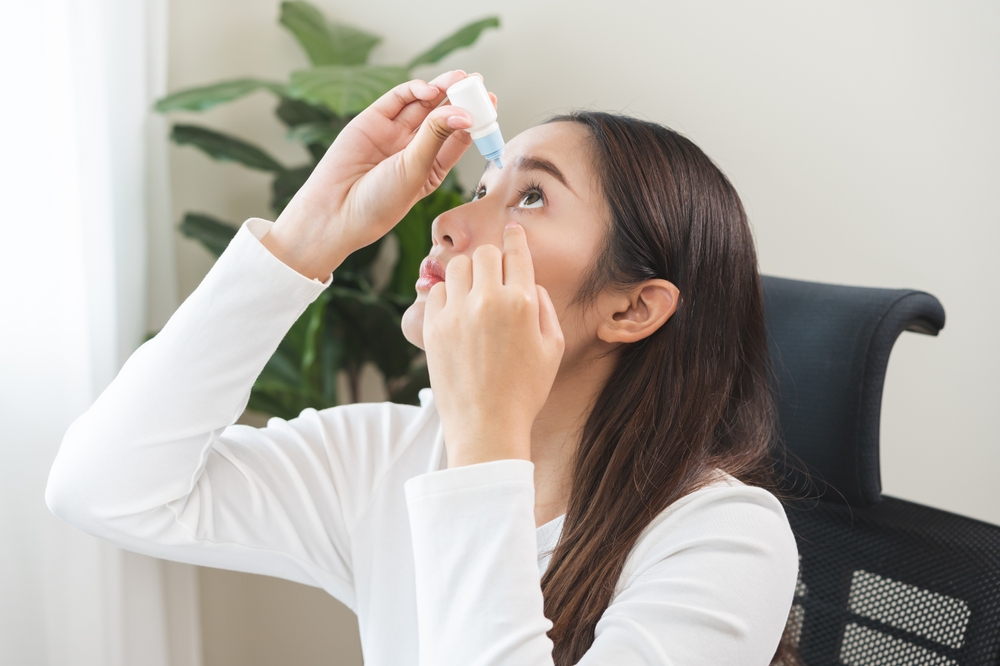
Dry eye syndrome occurs when your eyes do not produce enough tears or the tears they produce are of poor quality. This can cause discomfort, blurred vision, and even inflammation. Symptoms like a persistent gritty or itchy feeling are common, but many treatment options are available.
Lifestyle Adjustments for Dry Eyes
Small daily changes can help manage symptoms. If you spend a lot of time using digital screens, it is essential to take regular breaks to allow your eyes to rest. These breaks help your eyes stay naturally lubricated. This is because prolonged screen time often reduces blinking frequency. When taking these breaks, blink several times to distribute moisture across your eyes.
Controlling your environment also plays a crucial role in improving comfort. Humidity levels should be adjusted, particularly in dry environments or during winter months. Using a humidifier in rooms where you spend the most time can help keep the air moist and prevent your eyes from drying out. Staying well-hydrated by drinking water regularly is another simple way to support eye health.
Dietary changes can also aid in maintaining tear health. Foods rich in omega-3 fatty acids, like salmon, sardines, and flaxseeds, support tear production and eye health. Additionally, when spending time outside, wear wraparound sunglasses. These protect your eyes from the wind and sun, which can exacerbate dry eye symptoms.
Over-the-Counter Eye Drops
Artificial tears are a common first step in treating dry eye syndrome. Two main types of eye drops are available over the counter:
- Options with preservatives.
- Preservative-free options.
If you need to use drops throughout the day, preservative-free drops are the gentler option. They are also less likely to irritate with repeated use.
Gel-based eye drops offer longer-lasting moisture and can be particularly useful at night. However, due to their thicker consistency, they can temporarily blur your vision. It is important not to overuse eye drops. Overuse can lead to rebound dryness, where your eyes become dependent on artificial tears for lubrication.
Prescription Medications
You may need prescription medication if over-the-counter remedies do not provide enough relief. Some prescription options, such as Restasis, reduce inflammation in your tear glands. These also boost natural tear production. Another medication, Xiidra, specifically targets and blocks inflammation-causing proteins in the eyes.
Prescription treatments can take several months to show noticeable results. Sometimes, doctors may also prescribe corticosteroid eye drops for short-term inflammation relief. However, these drops are typically not used long-term due to potential side effects. Some of the risks include increased eye pressure or cataract development.
Tear Duct Plugs
In more severe cases, your doctor might suggest tear duct plugs. These tiny devices are placed in your tear ducts to slow the drainage of tears, allowing more moisture to stay on the surface of your eyes. There are two main types of tear duct plugs: temporary plugs that dissolve over time and permanent plugs that can be removed if necessary.
Inserting tear duct plugs is quick and painless and can be done in your doctor’s office. Many people experience immediate relief, as the retained moisture helps alleviate symptoms of dry eyes.
Advanced Treatments
For those who need more long-term relief, advanced treatments are available. These include:
- Intense Pulsed Light (IPL)
Here, targeted light helps reduce inflammation and improve the function of your Meibomian glands. These glands produce the oily component of your tears, which helps keep your eyes lubricated.
- LipiFlow
This combines gentle heat and pressure to unclog the Meibomian glands. It allows your eyes to produce better-quality tears.
Managing Dry Eye Syndrome
Living with dry eye syndrome can be frustrating, but relief is possible with the right combination of treatments. Start by making small lifestyle changes. You can start by taking breaks from screens, using a humidifier, and including omega-3-rich foods.
If these adjustments are insufficient, try over-the-counter eye drops or talk to your doctor about prescription options. Tear duct plugs and advanced therapies like IPL or LipiFlow can also significantly relieve more severe cases.
For more on dry eye syndrome, visit Magic City Eyecare at our Vestavia Hills, Alabama, office. Call (205) 506-2200 to schedule an appointment today.
https://my.clevelandclinic.org/health/diseases/24479-dry-eye











